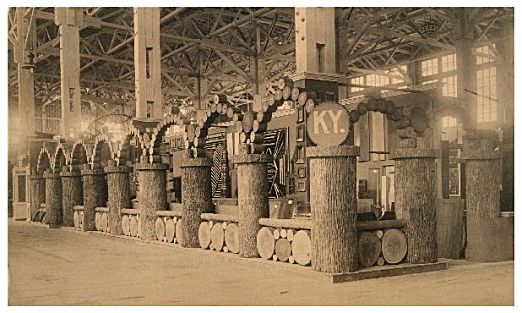Kentucky's State building was called- the "New Kentucky Home;" it stood opposite of the Palace of Mines and Metallurgy building, and covered an area of 138 by 80 feet. The 32,690 dollar three-story colonial structure had entrances on all four sides, emphasized by massive porches, flanked with sculpture groups, symbolical of mines, forestry, manufactures, agriculture and horticulture. The porches and verandas emphasized its aura of Southern hospitality and windows were designed with an Art Nouveau motif.
The interior sported a large reception hall, 56 by 60 feet, with beautiful hardwood floor. A large banquet hall was used occasionally for dignitaries.
In the very center of the main floor stood a statue of the famous Kentuckian,- George Rogers Clark. Photographs and oil paintings covered the walls of the first floor, while displays of embroideries and laces were showcased on the second story.
A room contained Stephen Collins Foster's desk were he wrote the words for "My Old Kentucky Home."
1 out of every 18 visitors to the Fair visited the Kentucky state building.
Kentucky's tobacco display was 4,000 square feet in size, the largest space assigned to any one product. Fifty-two of the 242 exhibitors showcased tobacco. There was shown in miniature or by pictures tobacco in every
phase of its culture and manufacture. A box of plug tobacco 3 feet square, the
largest ever made, was shown there.
In the Palace of Education, Kentucky's public schools, Catholic institutions,
commercial branches, colleges, and special schools were given due
prominence.
In the Palace of Mines and Metallurgy the general display combined both state and individual effort. Its 3,400 square feet of space faced on three of the main aisles of the building. Facing on three aisles the exhibit had three entrances, an arch of cannel coal, an arch of white limestone, and an arch of terra cotta burned in St. Louis from clay taken from Waco, Madison County. The arches were connected by a 3-foot wall of minerals, forming an inclosure for the exhibit.




